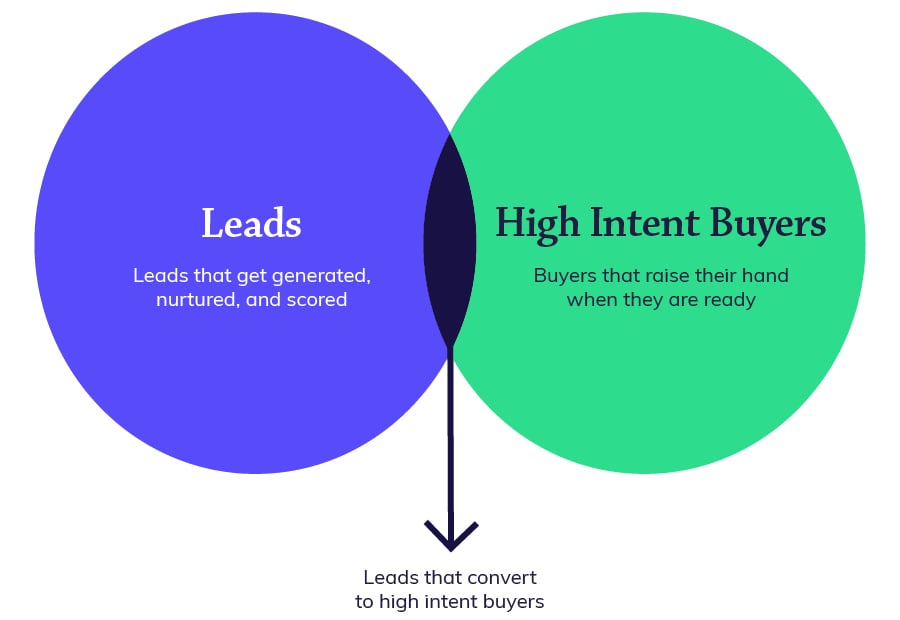Lead scoring often fails to deliver results because the behaviours that get scored don't correlate with intent to purchase, and buyers avoid doing the things that would lead to them being scored in the first place.
If you're frustrated with the fruits of your lead scoring labour, you're not alone. For many B2Bs, lead scoring never delivers its promise of higher lead to customer conversion rates, and most end up gaming their own systems, rendering them pointless. Buy why doesn’t lead scoring work so much of the time?
Behaviour doesn’t correlate with intent or ability to purchase
The often-held hope for lead scoring is that it will help marketing identify the leads that are more likely to purchase. It's hoped that these leads, when passed to sales, will be easier or more willing to close than the others, despite them not having explicitly expressed the desire to purchase.
The problem with this approach is that the behaviours that are most often scored, and our approach to scoring them, rarely, if ever, correlates with intent, or need, to purchase.

Frustratingly, leads that never can or will purchase are incredibly adept at performing the actions that marketers think only buyers will.
Even if behaviour did consistently correlate with intent or need, most approaches to creating scoring systems are spectacularly flawed. In the absence of any statistical analysis, scores that 'feel right' are assigned, of course with the intention to improve them later.
When Guy Marion was Head of Online Sales for Zendesk, he put lead scoring to the test. His sales team were given an equal number of qualified leads that had met their lead scoring target and of random, non-qualified leads, to see how much easier it was to close the scored leads. They found they were no better at closing the scored leads than the randomly selected ones.
Despite our best efforts, we found no statistical difference in our ability to connect with, re-engage, or win the “ready for sales” leads compared to randomized, non-scored leads. Admittedly, we only dedicated one quarter to the experiment, but the experience confirmed anecdotally what many report.
Guy Marion
In The Sales Acceleration Formula, Mark Roberge, former Chief Revenue Officer at HubSpot, wrote about how he quickly ditched traditional lead scoring and searched for a more reliable way to support sales.
At HubSpot, we tried the lead scoring approach, but ran into [problems]. We evolved to implement an alternative approach.
Mark Roberge
Buyers don’t become leads in the first place
Over the years that we've specialised in inbound demand generation, there's one trend that's always been present and has grown in recent years.
While marketing teams work hard to generate, nurture, and score leads that sales ultimately struggle to close, buyers still appear and explicitly raise their hand without being in a lead-nurture programme.
The effort that goes into generating more leads often correlates with moderate increases in the number of buyers appearing, but they remain two almost totally distinct cohorts.
Buyers increasingly don't want to receive automated emails as a result of downloading content - content that they've learned rarely contains enough value to warrant what inevitably comes after. Lead nurturing email is viewed as little more the spam these days. And they do not to want to take your phone call or read your 'inmail' pitch either.
Buyers would rather leave the gated content alone and remain anonymous until they're ready to talk to sales.
If you can provide enough information to satisfy your buyer's needs, you might capture their demand and generate a high-intent, highly qualified lead. If not, they'll probably go and look elsewhere.
What to do instead of lead scoring
If buyers are generally not converting into leads before raising their hands, and lead scoring doesn't help you to convert more leads into customers, how can you align your inbound marketing to your growth?
The answer is to shift your inbound from a lead generation strategy to a demand generation one.
Inbound demand generation takes all the best bits of inbound marketing and aligns them to the way your buyer wants to research and buy.
Inbound demand generation eschews the universal gating of content, followed up with lead nurturing email and scoring. Instead, it's an approach that helps buyers on their journey all the way from discovery to decision while remaining anonymous, with their privacy and inbox intact.
Inbound demand generation prioritises the free consumption of content - on your website, in Google search results, and on social media - to create demand for your offering and affinity with your brand.
It favours a holistic and integrated approach to the content that generates demand and the website user experience that captures it.
Inbound demand generation aligns marketing vectors so that more buyers discover your brand. More buyers consume your content to understand your expertise. And more buyers navigate your site and take a conversion action that benefits both them and you.
Explore deeper insights
If you want to learn more about the pitfalls of lead scoring and what you can do instead, we covered this topic in detail in an episode of our podcast, Demand Decoded - check out the recordings below:
Listen on Spotify:
Watch on YouTube:




